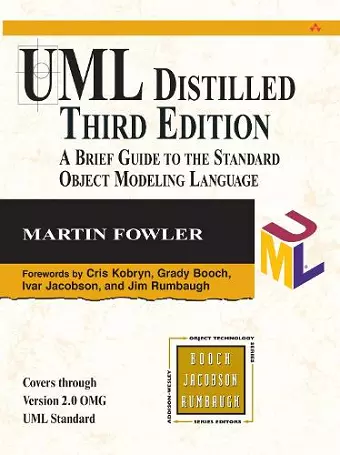UML Distilled
A Brief Guide to the Standard Object Modeling Language
Format:Paperback
Publisher:Pearson Education (US)
Published:2nd Oct '03
Should be back in stock very soon

Pressured with tight deadlines, application developers do not have the luxury of keeping completely up-to-date with all of the latest innovations in software engineering. Once in a great while, a tremendous resource comes along that helps these professionals become more efficient. The first two editions of UML Distilled have been perennial best-sellers because of their concise, yet thorough, nature. This eagerly-anticipated third edition allows you to get acquainted with some of the best thinking about efficient object-oriented software design using the latest version of the industry-standard for modeling software: UML 2.0. The author has retained the book's convenient format that has made it an essential resource for anyone who designs software for a living. The book describes all the major UML 2.0 diagram types, what they are intended to do, and the basic notation involved in creating and deciphering them. A true treasure for the software engineering community.
Gets students thinking about efficient object-oriented software design using UML 2.0. The book describes the major UML 2.0 diagram types, what they are intended to do, and the basic notation involved in creating and deciphering them, with a concise format.
More than 300,000 developers have benefited from past editions of UML Distilled . This third edition is the best resource for quick, no-nonsense insights into understanding and using UML 2.0 and prior versions of the UML.
Some readers will want to quickly get up to speed with the UML 2.0 and learn the essentials of the UML. Others will use this book as a handy, quick reference to the most common parts of the UML. The author delivers on both of these promises in a short, concise, and focused presentation.
This book describes all the major UML diagram types, what they're used for, and the basic notation involved in creating and deciphering them. These diagrams include class, sequence, object, package, deployment, use case, state machine, activity, communication, composite structure, component, interaction overview, and timing diagrams. The examples are clear and the explanations cut to the fundamental design logic. Includes a quick reference to the most useful parts of the UML notation and a useful summary of diagram types that were added to the UML 2.0.
If you are like most developers, you don't have time to keep up with all the new innovations in software engineering. This new edition of Fowler's classic work gets you acquainted with some of the best thinking about efficient object-oriented software design using the UML--in a convenient format that will be essential to anyone who designs software professionally.
ISBN: 9780321193681
Dimensions: 235mm x 180mm x 12mm
Weight: 340g
208 pages
3rd edition